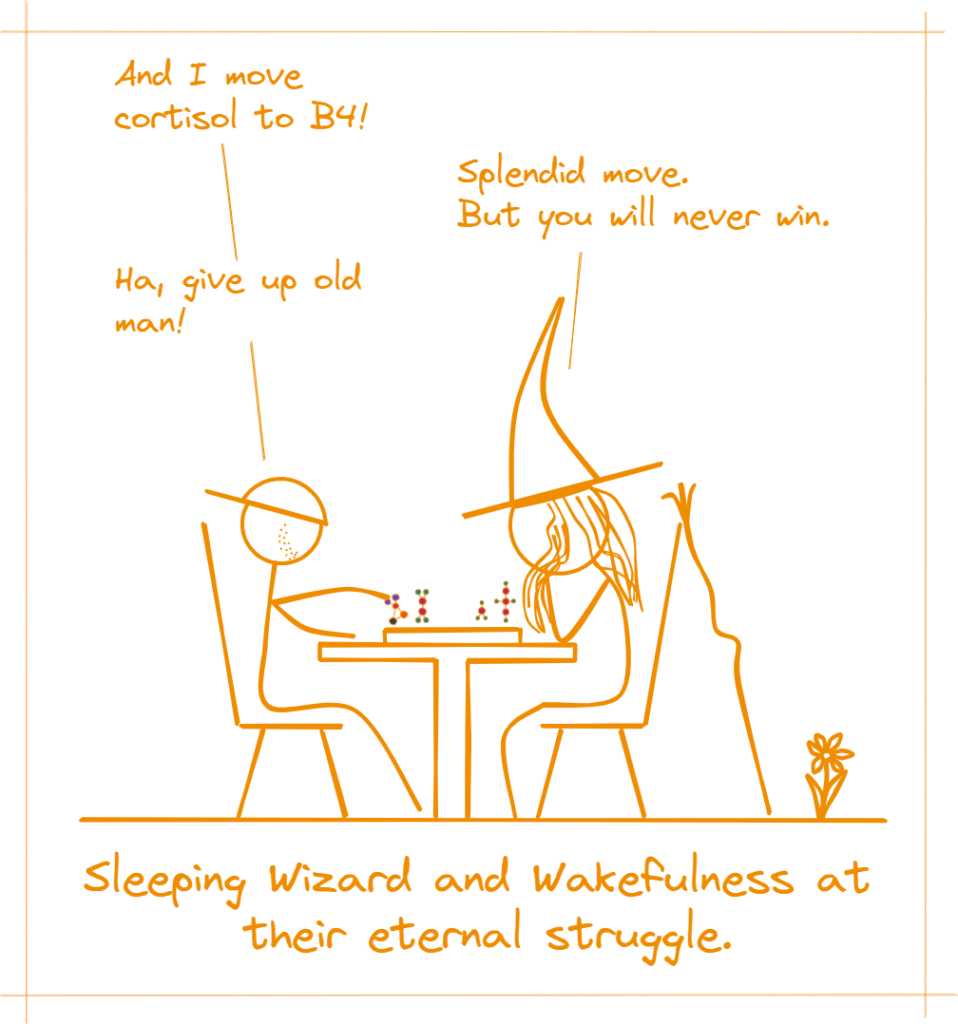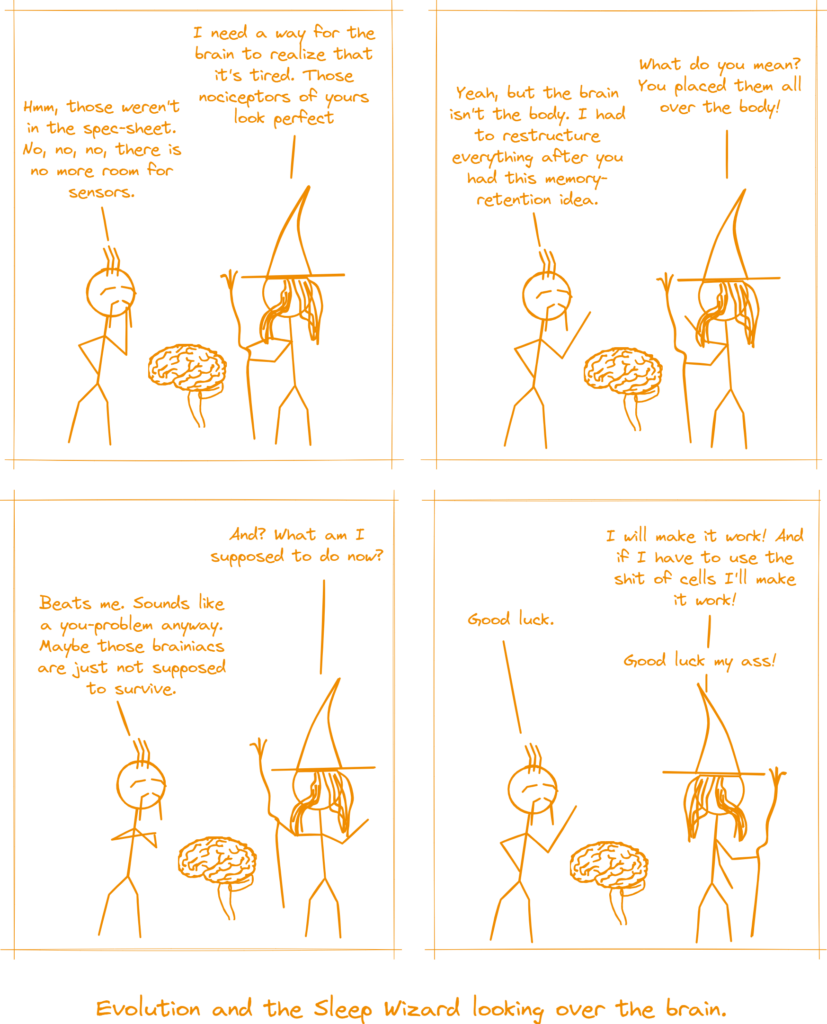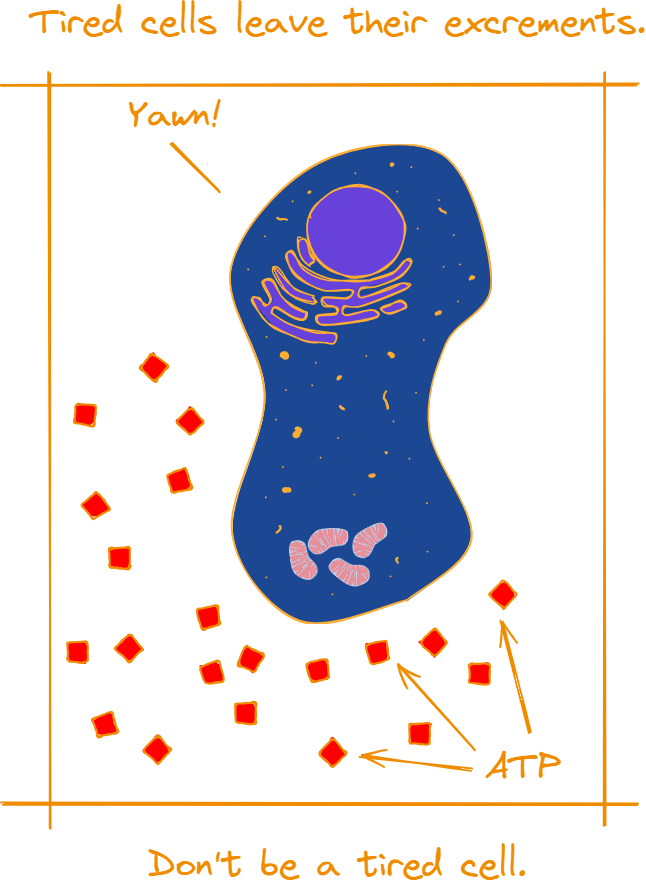Intro
As the day draws long, the common human gets tired regardless of their light-exposure, the position of the sun or the humdrum of any other celestial body. After hours of wakefulness even the most focused specimen will eventually succumb to the embrace of sleep, which means there is more to sleepiness than the impact of melatonin on the sleep- and wake-cycle.
In this article we will take a look into another mechanism; a cocktail of chemicals that the human’s internals brew into a literal sleep-potion, and make increasingly stronger the longer humans stay awake.
The sleep homeostasis chain
Sleep homeostasis is a game of balance between two eternal opponents. On the one side stands the drive to be awake, on the other the will to sleep. Their weapons of choice aren’t figurines on a board, but cytokines, hormones and other chemical compounds.

When humans are freshly awake these sleep regulatory substances (short: SRS) are locked away behind doors of trigger mechanisms and half-time instabilities. All that changes once wake-time extends. Besides the threatening impacts of sleep deprivation (the effects have been mentioned here) that loom on the horizon, other mechanisms come to life.
When evolution created the brain it made some…interesting design choices. One of which is that the brain can”feel” its own state about as good as a brick [Julius 2001, Smith 2018].

Instead to determine the length it has been awake it uses a trick. All living things release waste products; more so when they are active. When it comes to cells, one of these waste products is adenosin triphosphat or ATP, the currency of energy in all systems that are considered alive [Knowles 1980].
Neurons release ATP during operation and the brain keeps a constant “eye” on the level of this extracellular ATP that accumulates during wakefulness. [Krueger 2008]

It uses microglia that activate at the touch of this extracellular ATP. As the ATP-concentration rises, more and more microglia are activated, and the magic of sleepiness begins [Suzuki 2004].
The microglia that are activated in this way release a range of bioactive substances, among them SRS; one of which is tumor necrosis factor (TNF), another is interleukin 1 beta [Bianco 2005, Gabel 2007, Hide 2000, Suzuki 2004].
And then there is adenosine. Through the help of a number of receptors the extracellular ATP is grabbed by extra active receptors and through a number of steps converted to adenosine [Gao 2024]. The organic compound is probably the most known SRS and rightfully so. Humans go so far to consume over 2 billion cups of coffee to block adenosine receptors and block the effect of the SRS of the same name. [Chin 2008, Ingraham 2015].
Once released and rampaging through the central nervous system, adenosine, TNF, interleukin 1 beta and all the other SRS hit human wakefulness like a dump-truck [Clinton 2011].
Outro
It is for this reason, that the longer humans stay awake, the more SRS accumulate and strengthen the sleep-drive. Only after the human gives in and lets sleep do its deeds does it release its grip on human wakefulness.
Sources
| Key | Citation |
|---|---|
| Bianco 2005 | Bianco, F., Pravettoni, E., Colombo, A., Schenk, U., Möller, T., Matteoli, M., & Verderio, C. (2005). Astrocyte-derived ATP induces vesicle shedding and IL-1β release from microglia. The Journal of Immunology, 174(11), 7268-7277. |
| Chin 2008 | Chin, J. M., Merves, M. L., Goldberger, B. A., Sampson-Cone, A., & Cone, E. J. (2008). Caffeine content of brewed teas. Journal of analytical toxicology, 32(8), 702-704. |
| Clinton 2011 | Clinton, J. M., Davis, C. J., Zielinski, M. R., Jewett, K. A., & Krueger, J. M. (2011). Biochemical regulation of sleep and sleep biomarkers. Journal of Clinical Sleep Medicine, 7(5 Suppl), S38-S42. |
| Gabel 2007 | Gabel, C. A. (2007). P2 purinergic receptor modulation of cytokine production. Purinergic Signalling, 3, 27-38. |
| Gao 2024 | Gao, Z., Guan, J., Yin, S., & Liu, F. (2024). The role of ATP in sleep-wake regulation: In adenosine-dependent and-independent manner. Sleep Medicine. |
| Hide 2000 | Hide, I., Tanaka, M., Inoue, A., Nakajima, K., Kohsaka, S., Inoue, K., & Nakata, Y. (2000). Extracellular ATP triggers tumor necrosis factor‐α release from rat microglia. Journal of neurochemistry, 75(3), 965-972. |
| Ingraham 2015 | Ingrahim, Christopher. Ferdman, Roberto. (2015). A coffee addict’s guide to the universe. Washington Post. https://www.washingtonpost.com/news/wonk/wp/2015/06/17/19-maps-and-charts-that-explain-pretty-much-everything-about-coffee/ |
| Julius 2001 | Julius, D., & Basbaum, A. I. (2001). Molecular mechanisms of nociception. Nature, 413(6852), 203-210. |
| Knowles 1980 | Knowles, J. R. (1980). Enzyme-catalyzed phosphoryl transfer reactions. Annual review of biochemistry, 49(1), 877-919. |
| Krueger 2008 | Krueger, J. M., Rector, D. M., Roy, S., Van Dongen, H. P., Belenky, G., & Panksepp, J. (2008). Sleep as a fundamental property of neuronal assemblies. Nature Reviews Neuroscience, 9(12), 910-919. |
| Smith 2018 | St. John Smith, E. (2018). Advances in understanding nociception and neuropathic pain. Journal of neurology, 265(2), 231-238. |
| Suzuki 2004 | Suzuki, T., Hide, I., Ido, K., Kohsaka, S., Inoue, K., & Nakata, Y. (2004). Production and release of neuroprotective tumor necrosis factor by P2X7 receptor-activated microglia. Journal of Neuroscience, 24(1), 1-7. |


Leave a Reply